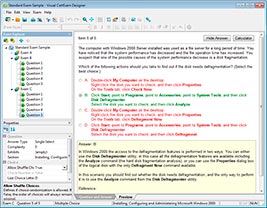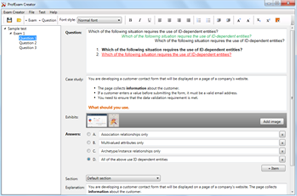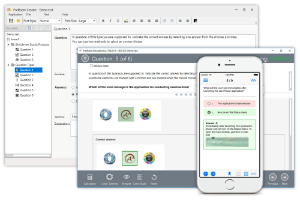Download MuleSoft Certified Integration Architect - Level 1.MCIA-Level-1.VCEplus.2025-04-16.111q.vcex
| Vendor: | Mulesoft |
| Exam Code: | MCIA-Level-1 |
| Exam Name: | MuleSoft Certified Integration Architect - Level 1 |
| Date: | Apr 16, 2025 |
| File Size: | 8 MB |
How to open VCEX files?
Files with VCEX extension can be opened by ProfExam Simulator.
Purchase
Coupon: TAURUSSIM_20OFF
Discount: 20%
Demo Questions
Question 1
A Mule application contains a Batch Job scope with several Batch Step scopes. The Batch Job scope is configured with a batch block size of 25.
A payload with 4,000 records is received by the Batch Job scope.
When there are no errors, how does the Batch Job scope process records within and between the Batch Step scopes?
- The Batch Job scope processes multiple record blocks in parallel, and a block of 25 records can jump ahead to the next Batch Step scope over an earlier block of records Each Batch Step scope is invoked with one record inthe payload of the received Mule event For each Batch Step scope, all 25 records within a block are processed in parallel All the records in a block must be completed before the block of 25 records is available to the next Batch Step scope
- The Batch Job scope processes each record block sequentially, one at a time Each Batch Step scope is invoked with one record in the payload of the received Mule event For each Batch Step scope, all 25 records within ablock are processed sequentially, one at a time All 4000 records must be completed before the blocks of records are available to the next Batch Step scope
- The Batch Job scope processes multiple record blocks in parallel, and a block of 25 records can jump ahead to the next Batch Step scope over an earlier block of records Each Batch Step scope is invoked with one record inthe payload of the received Mule event For each Batch Step scope, all 25 records within a block are processed sequentially, one record at a time All the records in a block must be completed before the block of 25 records is available to the next Batch Step scope
- The Batch Job scope processes multiple record blocks in parallel Each Batch Step scope is invoked with a batch of 25 records in the payload of the received Mule event For each Batch Step scope, all 4000 records areprocessed in parallel Individual records can jump ahead to the next Batch Step scope before the rest of the records finish processing in the current Batch Step scope
Correct answer: A
Explanation:
Reference: https://docs.mulesoft.com/mule-runtime/4.4/batch-processing-concept Reference:
https://docs.mulesoft.com/mule-runtime/4.4/batch-processing-concept
Question 2
To implement predictive maintenance on its machinery equipment, ACME Tractors has installed thousands of IoT sensors that will send data for each machinery asset as sequences of JMS messages, in near real-time, to a JMS queue named SENSOR_DATA on a JMS server. The Mule application contains a JMS Listener operation configured to receive incoming messages from the JMS servers SENSOR_DATA JMS queue. The Mule application persists each received
JMS message, then sends a transformed version of the corresponding Mule event to the machinery equipment back-end systems.
The Mule application will be deployed to a multi-node, customer-hosted Mule runtime cluster.
Under normal conditions, each JMS message should be processed exactly once.
How should the JMS Listener be configured to maximize performance and concurrent message processing of the JMS queue?
- Set numberOfConsumers = 1Set primaryNodeOnly = false
- Set numberOfConsumers = 1Set primaryNodeOnly = true
- Set numberOfConsumers to a value greater than oneSet primaryNodeOnly = true
- Set numberOfConsumers to a value greater than oneSet primaryNodeOnly = false
Correct answer: D
Explanation:
Reference: https://docs.mulesoft.com/jms-connector/1.8/jms-performance Reference:
https://docs.mulesoft.com/jms-connector/1.8/jms-performance
Question 3
A stock broking company makes use of CloudHub VPC to deploy Mule applications. Mule application needs to connect to a database application in the customers on-premises corporate data center and also to a Kafka cluster running in AWS VPC.
How is access enabled for the API to connect to the database application and Kafka cluster securely?
- Set up a transit gateway to the customers on-premises corporate datacenter to AWS VPC
- Setup AnyPoint VPN to the customer's on-premise corporate data center and VPC peering with AWS VPC
- Setup VPC peering with AWS VPC and the customers devices corporate data center
- Setup VPC peering with the customers onto my service corporate data center and Anypoint VPN to AWS VPC
Correct answer: B
Question 4
An organization if struggling frequent plugin version upgrades and external plugin project dependencies. The team wants to minimize the impact on applications by creating best practices that will define a set of default dependencies across all new and in progress projects.
How can these best practices be achieved with the applications having the least amount of responsibility?
- Create a Mule plugin project with all the dependencies and add it as a dependency in each application's POM.xml file
- Create a mule domain project with all the dependencies define in its POM.xml file and add each application to the domain Project
- Add all dependencies in each application's POM.xml file
- Create a parent POM of all the required dependencies and reference each in each application's POM.xml file
Correct answer: D
Question 5
A finance giant is planning to migrate all its Mule applications to Runtime fabric (RTF). Currently all Mule applications are deployed cloud hub using automated CI/CD scripts. As an integration architect, which of the below step would you suggest to ensure that the applications from cloudhub are migrated properly to Runtime Fabric (RTF) with an assumption that organization is keen on keeping the same deployment strategy.
- No changes need to be made to POM.xml file and CI/CD script should be modified as per the RTF configurations
- runtimeFabric dependency should be added as a mule plug-in to POM.xml file and CI/CD script should be modified as per the RTF configurations
- runtimeFabric deployment should be added to POM.xml file in all the mule applications and CI/CD script should be modified as per the RTF configurations
- runtimeFabric profile should be added mule configuration files in the mule applications and CI/CD script should be modified as per the RTF configurations
Correct answer: C
Question 6
A banking company is developing a new set of APIs for its online business. One of the critical API's is a master lookup API which is a system API. This master lookup API uses persistent object store. This API will be used by all other APIs to provide master lookup data.

Master lookup API is deployed on two cloudhub workers of 0.1 vCore each because there is a lot of master data to be cached. Master lookup data is stored as a key value pair. The cache gets refreshed if they key is not found in the cache. Doing performance testing it was observed that the Master lookup API has a higher response time due to database queries execution to fetch the master lookup data.
Due to this performance issue, go-live of the online business is on hold which could cause potential financial loss to Bank.
As an integration architect, which of the below option you would suggest to resolve performance issue?
- Implement HTTP caching policy for all GET endpoints for the master lookup API and implementlocking to synchronize access to object store
- Upgrade vCore size from 0.1 vCore to 0,2 vCore
- Implement HTTP caching policy for all GET endpoints for master lookup API
- Add an additional Cloudhub worker to provide additional capacity
Correct answer: A
Question 7
An XA transaction Is being configured that involves a JMS connector listening for Incoming JMS messages.
What is the meaning of the timeout attribute of the XA transaction, and what happens after the timeout expires?
- The time that is allowed to pass between committing the transaction and the completion of the Mule flow After the timeout, flow processing triggers an error
- The time that Is allowed to pass between receiving JMS messages on the same JMS connection After the timeout, a new JMS connection Is established
- The time that Is allowed to pass without the transaction being ended explicitly After the timeout, the transaction Is forcefully rolled-back
- The time that Is allowed to pass for state JMS consumer threads to be destroyed After the timeout, a new JMS consumer thread is created
Correct answer: C
Explanation:
* Setting a transaction timeout for the Bitronix transaction managerSet the transaction timeout eitherIn wrapper.confIn CloudHub in the Properties tab of the Mule application deployment ?The default is 60 secs. It is defined asmule.bitronix.transactiontimeout = 120* This property defines the timeout for each transaction created for this manager. If the transaction has not terminated before the timeout expires it will be automatically rolled back.--------------------------------------------------------------------------------------------------------------------- Additional Info around Transaction Management:Bitronix is available as the XA transaction manager for Mule applications ?To use Bitronix, declare it as a global configuration element in the Mule application<bti:transaction-manager />Each Mule runtime can have only one instance of a Bitronix transaction manager, which is shared by all Mule applicationsFor customer-hosted deployments, define the XA transaction manager in a Mule domainThen share this global element among all Mule applications in the Mule runtime * Setting a transaction timeout for the Bitronix transaction manager
Set the transaction timeout either
In wrapper.conf
In CloudHub in the Properties tab of the Mule application deployment ?
The default is 60 secs. It is defined as
mule.bitronix.transactiontimeout = 120
* This property defines the timeout for each transaction created for this manager.
If the transaction has not terminated before the timeout expires it will be automatically rolled back.
--------------------------------------------------------------------------------------------------------------------- Additional Info around Transaction Management:
Bitronix is available as the XA transaction manager for Mule applications ?
To use Bitronix, declare it as a global configuration element in the Mule application
<bti:transaction-manager />
Each Mule runtime can have only one instance of a Bitronix transaction manager, which is shared by all Mule applications
For customer-hosted deployments, define the XA transaction manager in a Mule domain
Then share this global element among all Mule applications in the Mule runtime

Question 8
Refer to the exhibit.

A Mule 4 application has a parent flow that breaks up a JSON array payload into 200 separate items, then sends each item one at a time inside an Async scope to a VM queue. A second flow to process orders has a VM Listener on the same VM queue. The rest of this flow processes each received item by writing the item to a database. This Mule application is deployed to four CloudHub workers with persistent queues enabled.
What message processing guarantees are provided by the VM queue and the CloudHub workers, and how are VM messages routed among the CloudHub workers for each invocation of the parent flow under normal operating conditions where all the CloudHub workers remain online?
- EACH item VM message is processed AT MOST ONCE by ONE CloudHub worker, with workers chosen in a deterministic round-robin fashion Each of the four CloudHub workers can be expected to process 1/4 of the ItemVM messages (about 50 items)
- EACH item VM message is processed AT LEAST ONCE by ONE ARBITRARY CloudHub worker Each of the four CloudHub workers can be expected to process some item VM messages
- ALL Item VM messages are processed AT LEAST ONCE by the SAME CloudHub worker where the parent flow was invoked This one CloudHub worker processes ALL 200 item VM messages
- ALL item VM messages are processed AT MOST ONCE by ONE ARBITRARY CloudHub worker This one CloudHub worker processes ALL 200 item VM messages
Correct answer: B
Explanation:
Correct answer is EACH item VM message is processed AT LEAST ONCE by ONE ARBITRARY CloudHub worker. Each of the four CloudHub workers can be expected to process some item VM messages In Cloudhub, each persistent VM queue is listened on by every CloudHub worker - But each message is read and processed at least once by only one CloudHub worker and the duplicate processing is possible - If the CloudHub worker fails , the message can be read by another worker to prevent loss of messages and this can lead to duplicate processing - By default , every CloudHub worker's VM Listener receives different messages from VM Queue Referenece:https://dzone.com/articles/deploying-mulesoft-application-on-1-worker-vs-mult Correct answer is EACH item VM message is processed AT LEAST ONCE by ONE ARBITRARY CloudHub worker. Each of the four CloudHub workers can be expected to process some item VM messages In Cloudhub, each persistent VM queue is listened on by every CloudHub worker - But each message is read and processed at least once by only one CloudHub worker and the duplicate processing is possible - If the CloudHub worker fails , the message can be read by another worker to prevent loss of messages and this can lead to duplicate processing - By default , every CloudHub worker's VM Listener receives different messages from VM Queue Referenece:
https://dzone.com/articles/deploying-mulesoft-application-on-1-worker-vs-mult
Question 9
Refer to the exhibit.

An organization uses a 2-node Mute runtime cluster to host one stateless API implementation. The API is accessed over HTTPS through a load balancer that uses round-robin for load distribution. Two additional nodes have been added to the cluster and the load balancer has been configured to recognize the new nodes with no other change to the load balancer.
What average performance change is guaranteed to happen, assuming all cluster nodes are fully operational?
- 50% reduction in the response time of the API
- 100% increase in the throughput of the API
- 50% reduction In the JVM heap memory consumed by each node
- 50% reduction In the number of requests being received by each node
Correct answer: D
Question 10
An integration Mule application is deployed to a customer-hosted multi-node Mule 4 runtime duster.
The Mule application uses a Listener operation of a JMS connector to receive incoming messages from a JMS queue.
How are the messages consumed by the Mule application?
- Depending on the JMS provider's configuration, either all messages are consumed by ONLY the primary cluster node or else ALL messages are consumed by ALL cluster nodes
- Regardless of the Listener operation configuration, all messages are consumed by ALL cluster nodes
- Depending on the Listener operation configuration, either all messages are consumed by ONLY the primary cluster node or else EACH message is consumed by ANY ONE cluster node
- Regardless of the Listener operation configuration, all messages are consumed by ONLY the primary cluster node
Correct answer: C
Explanation:
Correct answer is Depending on the Listener operation configuration, either all messages are consumed by ONLY the primary cluster node or else EACH message is consumed by ANY ONE cluster node For applications running in clusters, you have to keep in mind the concept of primary node and how the connector will behave. When running in a cluster, the JMS listener default behavior will be to receive messages only in the primary node, no matter what kind of destination you are consuming from. In case of consuming messages from a Queue, you'll want to change this configuration to receive messages in all the nodes of the cluster, not just the primary.This can be done with the primaryNodeOnly parameter:<jms:listener config-ref="config" destination="${inputQueue}" primaryNodeOnly="false"/> Correct answer is Depending on the Listener operation configuration, either all messages are consumed by ONLY the primary cluster node or else EACH message is consumed by ANY ONE cluster node For applications running in clusters, you have to keep in mind the concept of primary node and how the connector will behave. When running in a cluster, the JMS listener default behavior will be to receive messages only in the primary node, no matter what kind of destination you are consuming from. In case of consuming messages from a Queue, you'll want to change this configuration to receive messages in all the nodes of the cluster, not just the primary.
This can be done with the primaryNodeOnly parameter:
<jms:listener config-ref="config" destination="${inputQueue}" primaryNodeOnly="false"/>
HOW TO OPEN VCE FILES
Use VCE Exam Simulator to open VCE files

HOW TO OPEN VCEX FILES
Use ProfExam Simulator to open VCEX files


ProfExam at a 20% markdown
You have the opportunity to purchase ProfExam at a 20% reduced price
Get Now!



